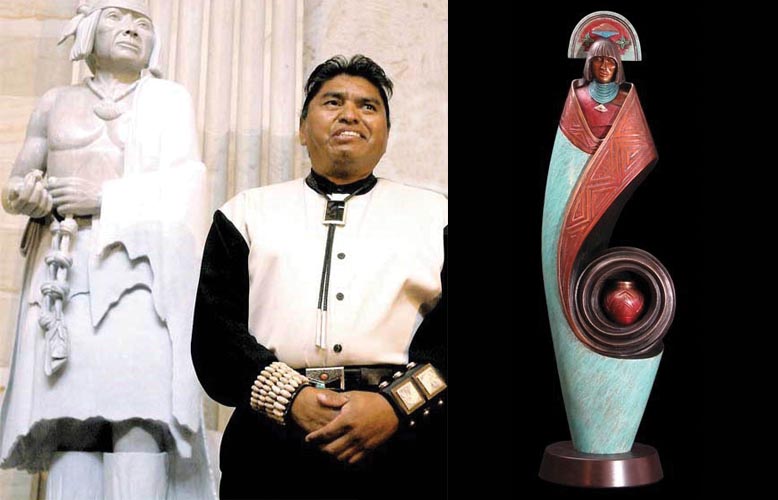Ask a discerning collector of Native American sculpture about a favorite piece and the name Cliff Fragua quickly gets mentioned. Offer his name to any well-known Native American artist in the Southwest, and instantly, a smile is followed by a story about this highly-respected Jemez Pueblo, New Mexico man and sculptor.
One hundred monumental statues adorn the U.S. Capitol in Washington D.C., two from every state. Six of those statues depict a Native American individual, but only one was actually sculpted by a Native American. Cliff Fragua’s work, Po’Pay, was unveiled in 2005. The submission to The Capitol, by New Mexico, was the 100th and final work.
The Spanish established themselves in the New Mexico region of the American Southwest in 1598 and conquered the Pueblo Peoples within thirty years of their arrival. In 1680, Po’Pay, one of their traditional spiritual leaders, secretly organized an uprising on August 13 that forced the Spanish to completely evacuate New Mexico. This push back against the Western World’s incursions and conquests is considered the most successful in the history of North America’s Native American resistance efforts.
The statue Po’Pay demonstrates a work by a sculptor who, after studying various art forms in the United States, traveled to Italy and learned European sculpting methodology, both of traditional perspectives and for working with various types of stone. Po’Pay exemplifies classical sculpture traditions, rather than modern or a stylized perspective, which might be expected by an Indigenous artist.
Fragua has won numerous awards, besides serving on committees and foundations that promote sensible, ethical practices within the Native American art world. His commitment to his traditional Pueblo homelands is reflected in his life as an artist and leader within his community. He practices the ways of the People, dresses according to tradition, and works with the Pueblo’s young to help them understand and properly practice their ways. Learning their language offers the foundation for that to occur.
Fragua is a pretty fair conga drum player and not just because he owns 28 sets of the drums. Next to emerging sculptures in his studio, some coming in at hundreds or thousands of pounds, are sets of free weights that are in use each day. A conversation with him about a work quickly turns to the stone comprising it, the image the form projects, and the feeling it creates.
A visitor soon appreciates how humble and intuitive this artists is — by holding back his ego, he allows the stones to sing during the creating process. The results are stunning yet gentle works done with consummate expertise.
Fragua will be in Central Oregon for three days in April: Sisters for the 4th Friday Art Walk April 28, a presentation on Saturday, April 29 and a working demonstration on April 30. New works will be unveiled during this weekend.
All appearances will take place at Raven Makes Gallery, located at 182 East Hood Ave.

